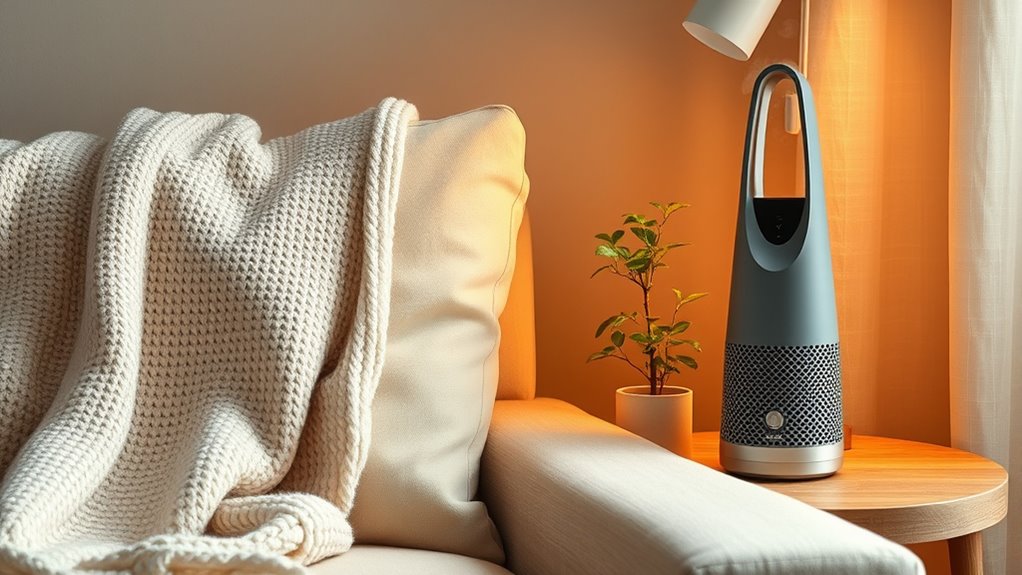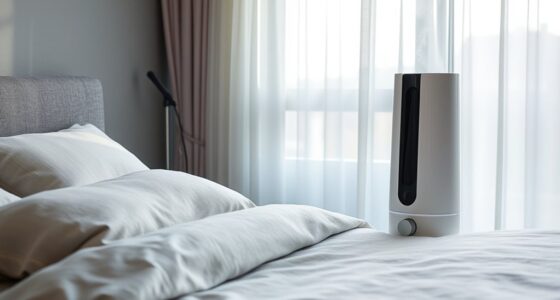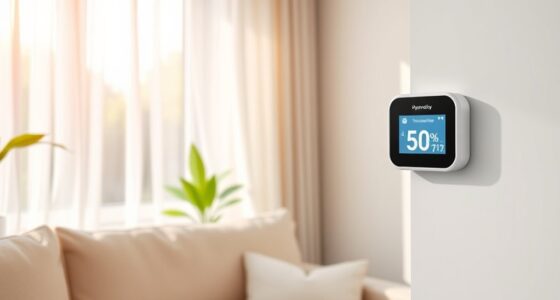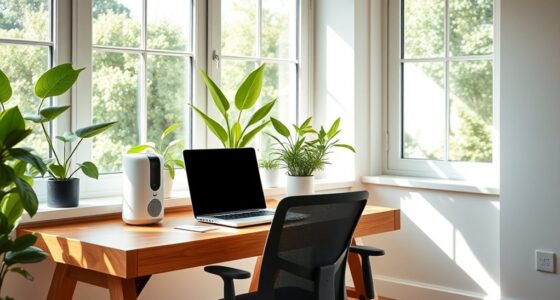To prevent skin dryness and irritation indoors, you should focus on improving air quality and humidity levels. Using an air purifier helps remove pollutants, dust, and pet dander that can worsen skin issues, while maintaining humidity between 40-60% keeps your skin hydrated and supports its natural barrier. Combining these strategies with regular cleaning and hydrating skincare boosts your skin’s health and resilience. Keep exploring to learn more ways to protect your skin indoors.
Key Takeaways
- Use air purifiers to remove airborne pollutants and reduce skin irritants indoors.
- Maintain indoor humidity levels between 40-60% to prevent skin dryness and barrier damage.
- Regularly clean and ventilate your home to minimize dust, mold, and allergens that can cause skin reactions.
- Incorporate hydrating skincare products with ingredients like hyaluronic acid to boost skin moisture.
- Combine air purification with humidity control for a healthier indoor environment that supports skin hydration.
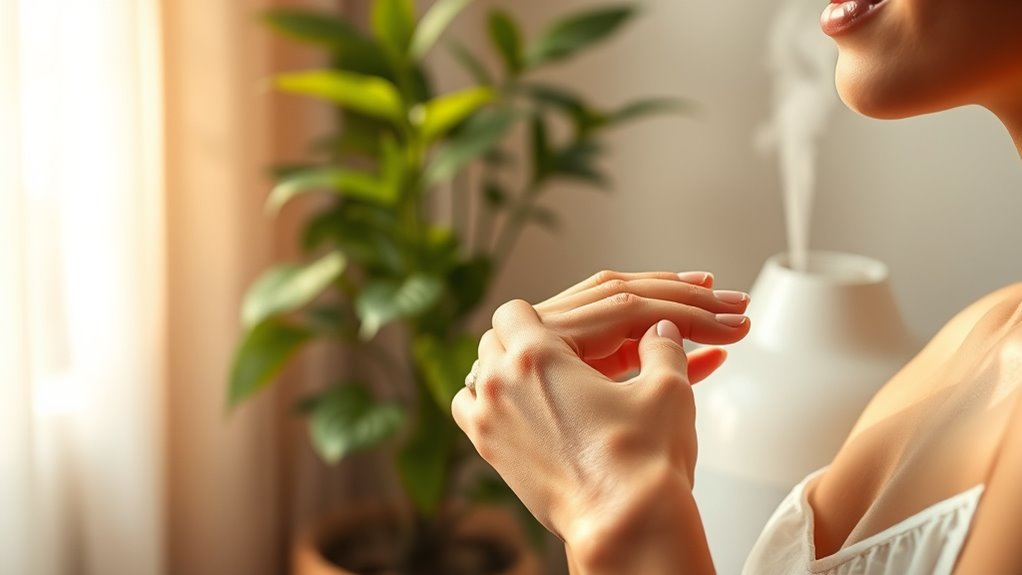
Have you ever wondered how the air inside your home affects your skin? The truth is, indoor air quality plays a significant role in your skin’s health, influencing everything from hydration to irritation. Poor air quality can dry out your skin, making it flaky, itchy, and more prone to redness. To combat this, focusing on air purification and humidity control is essential. These two strategies work together to create an environment that supports healthy, moisturized skin.
Air purification helps eliminate airborne pollutants, dust, pet dander, and other irritants that can exacerbate skin issues. When you invest in a good air purifier, you’re actively reducing the presence of allergens and toxic particles that can settle on your skin or trigger allergic reactions. Clean air means fewer irritants that can cause inflammation or dryness. It’s especially important if you have sensitive skin or allergies, as pollutants can compromise your skin’s barrier, leading to increased dryness and irritation.
Humidity control is equally crucial. Indoor air tends to become dry, especially during winter or in homes with central heating and air conditioning. Low humidity strips moisture from your skin, leaving it feeling tight, rough, and prone to cracking. Maintaining ideal humidity levels—generally between 40-60%—helps keep your skin hydrated from the inside out. Using a humidifier is a simple yet effective way to add moisture back into the air, preventing your skin from becoming parched. When the air is properly humidified, your skin’s natural barrier stays intact, reducing the likelihood of irritation and dryness.
Combining air purification with humidity control creates a balanced indoor environment that supports skin health. When pollutants are filtered out, and moisture levels are maintained, your skin is less likely to become irritated or overly dry. This synergy not only improves your comfort but also reduces the frequency of skin flare-ups and reactions. Additionally, regular cleaning and ventilating your home help keep the air fresh and free from dust and mold, further protecting your skin. Incorporating skincare innovation such as products with hydrating ingredients like hyaluronic acid can further enhance your skin’s resilience in indoor environments.
Frequently Asked Questions
How Does Indoor Humidity Affect Skin Hydration?
Higher humidity levels help maintain your skin moisture, preventing dryness and irritation. When indoor air is too dry, your skin loses moisture quickly, leading to flakiness and discomfort. By keeping humidity balanced, you support your skin’s natural barrier, making it less prone to irritation. You can use humidifiers or houseplants to boost indoor humidity, ensuring your skin stays hydrated, healthy, and comfortable all day long.
Can Air Purifiers Improve Skin Health Indoors?
Think of an air purifier as a gentle gardener tending your home’s air, removing pollutants that can irritate your skin. Yes, air purifier benefits include creating a skin-friendly air environment, reducing allergens, dust, and pollutants that cause dryness and irritation. By filtering out irritants, you let your skin breathe easier, stay hydrated, and feel more comfortable indoors. Investing in a good air purifier can be a simple step toward healthier, happier skin.
What Indoor Plants Help Maintain Skin-Friendly Air Quality?
You can improve skin-friendly air quality by choosing indoor plants like pothos, peace lilies, and snake plants. These plants help with plant selection for air purification and humidity regulation, which prevents dryness and irritation. As they release moisture and filter airborne toxins, they create a more comfortable environment. Regular watering and proper placement boost their benefits, ensuring your indoor air supports healthy, hydrated skin.
Are There Specific Allergens That Worsen Skin Dryness?
Imagine your skin as a delicate garden, and allergen triggers are like invasive weeds. These triggers, such as pet dander, pollen, or dust mites, can worsen skin dryness and cause reactions like redness or irritation. When you’re exposed, your skin reacts defensively, making dryness worse. To protect your garden, avoid these allergen triggers, keep your environment clean, and use gentle skincare to prevent your skin from becoming a barren, irritated landscape.
How Often Should Indoor Air Be Ventilated for Skin Health?
You should aim for air exchange through ventilation at least once every 2 to 3 hours to promote healthy skin. Regular ventilation diminishes indoor pollutants and maintains moisture levels, preventing dryness and irritation. Increase ventilation frequency if you notice stuffiness or signs of poor air quality. Using exhaust fans or opening windows helps guarantee fresh air circulation, supporting both your skin’s health and overall indoor environment.
Conclusion
By maintaining clean, humidified indoor air, you protect your skin from dryness, irritation, and discomfort. By controlling heating and cooling systems, you prevent fluctuations that strip moisture away. By using gentle skincare and avoiding harsh products, you nurture your skin’s natural barrier. By staying aware of your indoor environment, you create a space that supports skin health and comfort. Together, these steps help you breathe easier, feel better, and enjoy healthier, more radiant skin every day.
